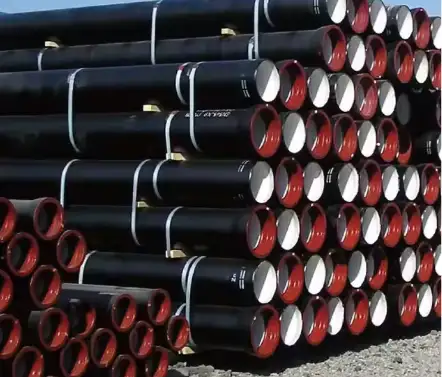Understanding the weight of a 16-inch ductile iron pipe is crucial for various aspects of infrastructure planning, including transportation, installation, and structural support. Ductile iron pipes are renowned for their strength, durability, and versatility in water and wastewater systems. This article delves into the specifics of 16-inch ductile iron pipes, providing detailed information on their weight, influencing factors, and practical considerations.

1. Standard Weight of a 16-Inch Ductile Iron Pipe
The weight of a 16-inch ductile iron pipe varies based on its wall thickness class. According to the American Water Works Association (AWWA) standards, the weight per foot for a 16-inch pipe is as follows:
-
Class 350: Approximately 49.3 pounds per foot.
-
Class 400: Approximately 53.0 pounds per foot.
-
Class 450: Approximately 57.2 pounds per foot.
These weights are based on the pipe being cement-lined, which adds additional weight. The cement lining provides corrosion resistance, extending the lifespan of the pipe.
2. Factors Influencing the Weight of Ductile Iron Pipes
Several factors contribute to the overall weight of a ductile iron pipe:
a. Wall Thickness Class
The wall thickness class determines the pipe’s pressure rating and, consequently, its weight. Higher classes have thicker walls, resulting in increased weight.
b. Cement Lining
Cement lining is standard in ductile iron pipes to prevent internal corrosion. The thickness of the cement lining can add several pounds per foot to the pipe’s weight. For instance, a 16-inch pipe with a cement lining adds approximately 5 pounds per foot .
c. Pipe Length
Standard lengths for ductile iron pipes are typically 18 feet. The total weight of a pipe section is the weight per foot multiplied by the length.
d. Coatings and Linings
Additional coatings, such as asphaltic coatings or polyethylene encasements, can add weight to the pipe. These coatings provide external corrosion protection.
3. Comparison with Other Pipe Materials
| Pipe Material | Weight per Foot (16″) | Durability | Cost | Common Applications |
|---|---|---|---|---|
| Ductile Iron | 49.3–57.2 lbs | High | Moderate | Water and wastewater systems |
| Cast Iron | 45–50 lbs | Moderate | Low | Older infrastructure systems |
| Steel | 40–45 lbs | High | High | Industrial applications |
| PVC (Pressure Rated) | 20–25 lbs | Low | Low | Residential water systems |
Ductile iron pipes offer a balance between weight and strength, making them suitable for high-pressure applications.
4. Practical Considerations for Handling and Installation
a. Transportation
Due to their weight, transporting 16-inch ductile iron pipes requires appropriate equipment, such as flatbed trucks and cranes. Proper securing is essential to prevent damage during transit.
b. Installation
The weight of the pipes necessitates careful planning during installation. Lifting equipment like cranes or pipe rollers is often used. Additionally, adequate bedding and support are required to prevent sagging or misalignment.
c. Storage
Before installation, pipes should be stored on level ground, away from traffic, and protected from environmental elements to prevent corrosion and damage.
5. Environmental Impact and Sustainability
Ductile iron pipes are made from recycled materials and are themselves recyclable at the end of their service life. Their durability reduces the need for frequent replacements, contributing to sustainability.
6. Frequently Asked Questions (FAQs)
1. Why does the weight of a 16-inch ductile iron pipe matter?
The weight affects transportation logistics, installation methods, and the structural support needed during the pipe’s service life. Understanding the weight helps in planning and resource allocation.
2. How does the cement lining affect the pipe’s weight?
Cement lining adds to the pipe’s overall weight, but it is essential for corrosion resistance, thereby extending the pipe’s lifespan and reducing maintenance costs.
3. Can the weight of ductile iron pipes be reduced?
While the inherent properties of ductile iron determine its weight, innovations in pipe design and materials aim to reduce weight without compromising strength.
4. How does the weight of ductile iron pipes compare to other materials?
Ductile iron pipes are heavier than materials like PVC but offer superior strength and durability, making them suitable for high-pressure applications.
5. What are the challenges associated with the weight of ductile iron pipes?
The primary challenges include the need for specialized transportation and handling equipment, as well as the requirement for adequate installation support.
6. Are there alternatives to ductile iron pipes?
Yes, alternatives include PVC, HDPE, and steel pipes. Each material has its advantages and is chosen based on specific application requirements.
Conclusion
The weight of a 16-inch ductile iron pipe is influenced by factors such as wall thickness class, cement lining, and coatings. Understanding these factors is crucial for effective planning and execution of infrastructure projects. Ductile iron pipes offer a balance of strength and weight, making them a reliable choice for various applications.
YouTube Video:
References:
- AWWA C151 Standard for Ductile Iron Pipe – American Water Works Association
- Ductile Iron Pipe – Wikipedia
- Water Pipes and Corrosion Control – U.S. Environmental Protection Agency
- OSHA Guidelines for Safe Handling of Heavy Pipes – Occupational Safety and Health Administration
- Ductile Iron Properties and Applications – ScienceDirect Engineering Topics

